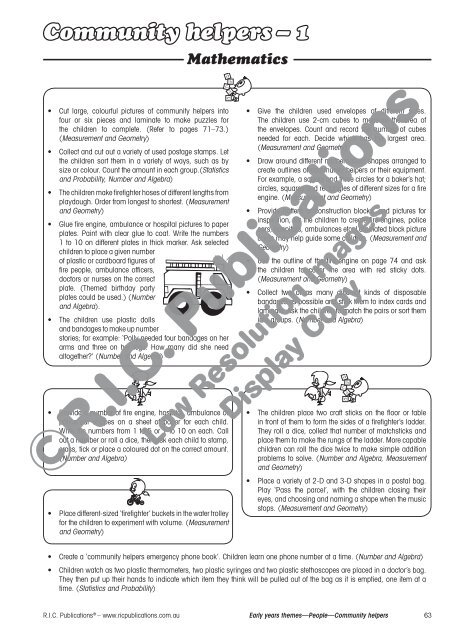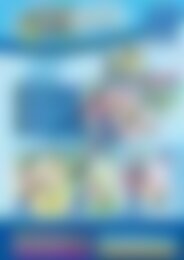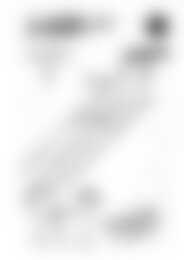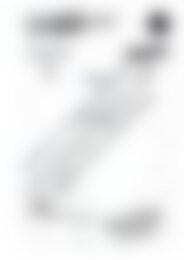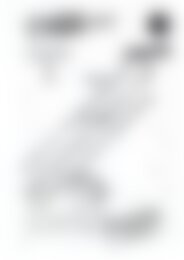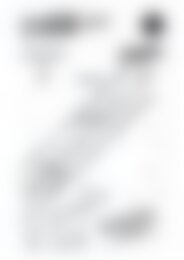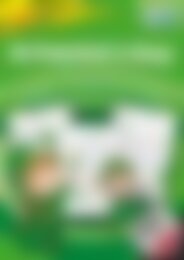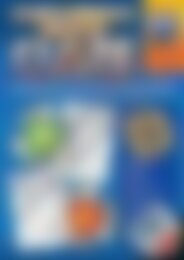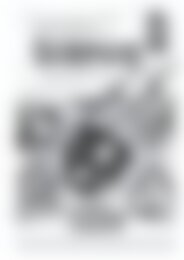RIC-20959 Early years People - Community Helpers
Create successful ePaper yourself
Turn your PDF publications into a flip-book with our unique Google optimized e-Paper software.
<strong>Community</strong> helpers – 1<br />
Mathematics<br />
• Cut large, colourful pictures of community helpers into<br />
four or six pieces and laminate to make puzzles for<br />
the children to complete. (Refer to pages 71–73.)<br />
(Measurement and Geometry)<br />
• Collect and cut out a variety of used postage stamps. Let<br />
the children sort them in a variety of ways, such as by<br />
size or colour. Count the amount in each group.(Statistics<br />
and Probability, Number and Algebra)<br />
• The children make firefighter hoses of different lengths from<br />
playdough. Order from longest to shortest. (Measurement<br />
and Geometry)<br />
• Glue fire engine, ambulance or hospital pictures to paper<br />
plates. Paint with clear glue to coat. Write the numbers<br />
1 to 10 on different plates in thick marker. Ask selected<br />
children to place a given number<br />
of plastic or cardboard figures of<br />
fire people, ambulance officers,<br />
doctors or nurses on the correct<br />
plate. (Themed birthday party<br />
plates could be used.) (Number<br />
and Algebra).<br />
• The children use plastic dolls<br />
and bandages to make up number<br />
stories; for example: ‘Polly needed four bandages on her<br />
arms and three on her legs. How many did she need<br />
altogether?’ (Number and Algebra)<br />
• Give the children used envelopes of different sizes.<br />
The children use 2-cm cubes to measure the area of<br />
the envelopes. Count and record the number of cubes<br />
needed for each. Decide which has the largest area.<br />
(Measurement and Geometry)<br />
• Draw around different mathematical shapes arranged to<br />
create outlines of community helpers or their equipment.<br />
For example, a square and three circles for a baker’s hat;<br />
circles, squares and rectangles of different sizes for a fire<br />
engine. (Measurement and Geometry)<br />
• Provide pattern or construction blocks, and pictures for<br />
inspiration, for the children to create fire engines, police<br />
cars, hospitals, ambulances etc. Laminated block picture<br />
cards may help guide some children. (Measurement and<br />
Geometry)<br />
• Use the outline of the fire engine on page 74 and ask<br />
the children to cover the area with red sticky dots.<br />
(Measurement and Geometry)<br />
• Collect two of as many different kinds of disposable<br />
bandages as possible and stick them to index cards and<br />
laminate. Ask the children to match the pairs or sort them<br />
into groups. (Number and Algebra)<br />
• Provide a number of fire engine, hospital, ambulance or<br />
police car shapes on a sheet of paper for each child.<br />
Write the numbers from 1 to 5 or 1 to 10 on each. Call<br />
out a number or roll a dice, then ask each child to stamp,<br />
cross, tick or place a coloured dot on the correct amount.<br />
(Number and Algebra)<br />
• Place different-sized ‘firefighter’ buckets in the water trolley<br />
for the children to experiment with volume. (Measurement<br />
and Geometry)<br />
• The children place two craft sticks on the floor or table<br />
in front of them to form the sides of a firefighter’s ladder.<br />
They roll a dice, collect that number of matchsticks and<br />
place them to make the rungs of the ladder. More capable<br />
children can roll the dice twice to make simple addition<br />
problems to solve. (Number and Algebra, Measurement<br />
and Geometry)<br />
• Place a variety of 2-D and 3-D shapes in a postal bag.<br />
Play ‘Pass the parcel’, with the children closing their<br />
eyes, and choosing and naming a shape when the music<br />
stops. (Measurement and Geometry)<br />
• Create a ‘community helpers emergency phone book’. Children learn one phone number at a time. (Number and Algebra)<br />
• Children watch as two plastic thermometers, two plastic syringes and two plastic stethoscopes are placed in a doctor’s bag.<br />
They then put up their hands to indicate which item they think will be pulled out of the bag as it is emptied, one item at a<br />
time. (Statistics and Probability)<br />
R.I.C. Publications ® – www.ricpublications.com.au <strong>Early</strong> <strong>years</strong> themes—<strong>People</strong>—<strong>Community</strong> helpers 63


